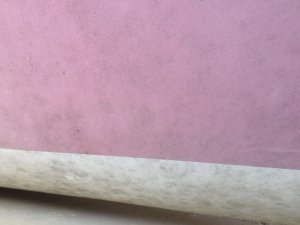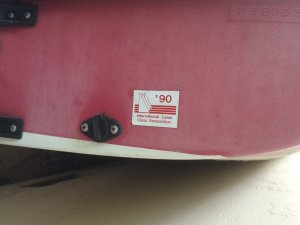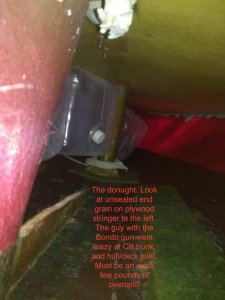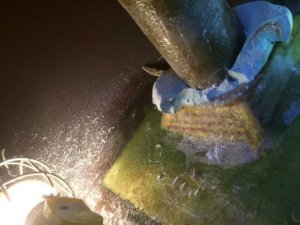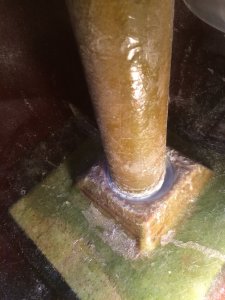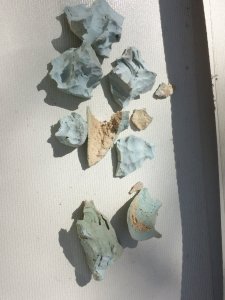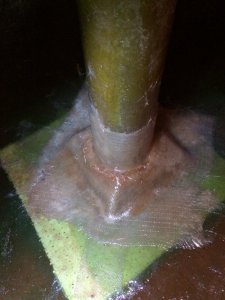So I picked up a 1990 hull in what I think is little used condition. Last summer I destroyed a 1975 softie--I had it for a few years and sailed it in big winds, and it was becoming quite a leaker despite my best efforts. It broke off its temporary mooring one night (no leaving boats overnight on Lake Tahoe public beaches any more) and ended up getting bashed around on the rocks. So I stripped it, and off to the dump it went.
Anyway, I came across this Pearson hull and got it for $150. The bottom is oxidized, and there are a few dings/wear points on the gunwale, but other than that it seems little or lightly used. The deck is perfectly solid, the mast step holds water, and there are no stress cracks anywhere on the deck or cockpit. There is an access hatch with a stow bag starboard of the CB trunk, and the inside air smells like resin, not musty Bay water.
I have read the Laser lore regarding the bad Pearson builds, and I want to beef the hull up in a few areas to see if I can maximize the life of the hull. I figure if I put another $100 in the hull--a couple of access hatches and some fiberglass cloth--for $250 and some project time I'll be doing OK, even if it doesn't have the longevity of another builder. I've already got epoxy and polish.
Looking through the access hatch I can see a few glops of Bondo, one at the base of the mast step, and in the CB trunk area (I can feel it along the deck/trunk joint, and there is a ribbon of it in the bilge that looks like it got away from the guy at the factory with the Bondo gun). The fore/aft plywood stringer forward of the CB trunk is bare untreated plywood on the top cut...before installing the deck it would have been really easy to seal the end grain with a little resin, right? The fiberglass inside the boat doesn't look "resin rich," which means less weight, but also kind of unfinished.
I've read the threads on installing an access hatch and dealing with the mast step. Is it pretty much the same thing with the CB trunk hull joint and deck joints? Chip off the excess Bondo, prep and add fiberglass?
To do both sides I'd have to put in another access hatch port of the CB trunk.
I'll try to post some photos of the project as I get organized.
Thanks,
Chris
Anyway, I came across this Pearson hull and got it for $150. The bottom is oxidized, and there are a few dings/wear points on the gunwale, but other than that it seems little or lightly used. The deck is perfectly solid, the mast step holds water, and there are no stress cracks anywhere on the deck or cockpit. There is an access hatch with a stow bag starboard of the CB trunk, and the inside air smells like resin, not musty Bay water.
I have read the Laser lore regarding the bad Pearson builds, and I want to beef the hull up in a few areas to see if I can maximize the life of the hull. I figure if I put another $100 in the hull--a couple of access hatches and some fiberglass cloth--for $250 and some project time I'll be doing OK, even if it doesn't have the longevity of another builder. I've already got epoxy and polish.
Looking through the access hatch I can see a few glops of Bondo, one at the base of the mast step, and in the CB trunk area (I can feel it along the deck/trunk joint, and there is a ribbon of it in the bilge that looks like it got away from the guy at the factory with the Bondo gun). The fore/aft plywood stringer forward of the CB trunk is bare untreated plywood on the top cut...before installing the deck it would have been really easy to seal the end grain with a little resin, right? The fiberglass inside the boat doesn't look "resin rich," which means less weight, but also kind of unfinished.
I've read the threads on installing an access hatch and dealing with the mast step. Is it pretty much the same thing with the CB trunk hull joint and deck joints? Chip off the excess Bondo, prep and add fiberglass?
To do both sides I'd have to put in another access hatch port of the CB trunk.
I'll try to post some photos of the project as I get organized.
Thanks,
Chris


